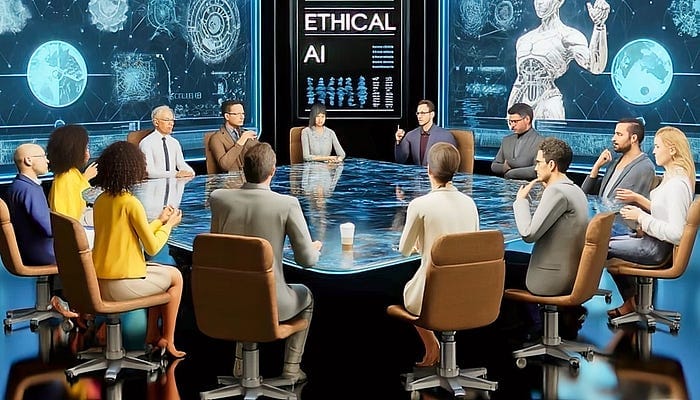Responsibility of Choice and Aligning AI with Human Values (Part 1 of 2)

Part 1 of this short essay will examine the importance of aligning AI with our human values. Part 2 will discuss the consequences of getting AI alignment right and getting it wrong.
The rise of artificial intelligence marks a critical moment in our history that has the potential to result in very positive outcomes for us, but this also carries a great responsibility. As AI systems become increasingly sophisticated, we face the critical challenge of ensuring they act in ways that uplift and benefit humanity. Aligning AI with our values is more than just a technical feat; it’s a moral imperative that demands we deeply understand AI’s computational mechanics and an even deeper understanding of human ethics and principles.
Human values are not a simple concept; they are rich and complex and deeply a part of our collective evolving cultural, personal, and societal functioning. What one community holds sacred, another may view differently. This plurality of values presents a formidable challenge in the quest for AI alignment.
The dynamic nature of what we deem “valuable” implies that simply programming AI with a static set of values may not suffice. We must explore flexible and adaptive approaches where AI systems can learn, grow, and refine their understanding of our values through real-world interactions and guidance.
Practical approaches have emerged as fundamental to navigating this complex landscape. Organizations like OpenAI emphasize the iterative training of AI using human feedback, allowing the system to learn and infer both explicit and implicit human intent. By grounding AI in the real world, where it can interact with, learn from, and be guided by human behavior, we can progressively steer it toward actions and decisions that resonate with our collective ethos.
Robustness is another cornerstone of alignment, ensuring AI systems perform reliably under various conditions without being derailed by unforeseen inputs or adversarial attacks. Just as civil engineers employ rigorous principles to safeguard the structural integrity of physical constructions against external forces and stresses, researchers in the field of AI are striving to develop methodologies that can predict and ensure the stability of AI systems. These efforts represent a thorough effort towards continual alignment of AI’s values with our own.
As AI capabilities grow, new alignment challenges will inevitably arise. Iterative alignment becomes necessary, allowing for adjustment and improvement of AI systems by our evolving human norms and values. This process acknowledges that perfect alignment is not possible. Instead, it focuses on the capacity for AI to adapt and be collaboratively corrected over time with us humans.
Given AI’s global impact, the pursuit of alignment cannot be the purview of a single entity, state, or sector. Transparency and widespread collaboration among researchers, developers, and the broader public are essential. Our collective commitment to openly sharing research findings reflects an understanding that the alignment task requires human oversight and input.
The practical implementation of AI alignment is filled with challenges — not only technical barriers but also ethical difficulties, such as which human values to prioritize and how to navigate different participants’ varied and sometimes conflicting interests. Furthermore, there’s the risk of deliberately or otherwise using alignment to perpetuate existing inequalities or biases. These are complex issues that demand thoughtful and inclusive dialogue.
The future of AI value alignment lies in an interdisciplinary approach that draws from AI safety research, moral philosophy, social sciences, and vigorous public discourse. The goal is to create AI that understands human values and respects their rich diversity, capable of making decisions that are considered just and fair across a broad spectrum of human perspectives.
Aligning AI with our values is an ongoing journey marked by uncertainty and the potential for unique shared innovation. This endeavor requires continuous effort, critical examination, and collective action. The aim is not just to prevent harm but to steer the future of AI towards augmenting the human experience with wisdom, fairness, and profound respect for the depth of our values.
Join Us Towards a Greater Understanding of AI
We hope you found insights and value in this post. If so, we invite you to become a more integral part of our community. By following us and sharing our content, you help spread awareness and foster a more informed and thoughtful conversation about the future of AI. Your voice matters, and we’re eager to hear your thoughts, questions, and suggestions on topics you’re curious about or wish to delve deeper into. Together, we can demystify AI, making it accessible and engaging for everyone. Let’s continue this journey towards a better understanding of AI. Please share your thoughts with us via email: marty@bearnetai.com, and don’t forget to follow and share BearNetAI with others who might also benefit from it. Your support makes all the difference.
Thank you for being a part of this fascinating journey.
BearNetAI. From Bytes to Insights. AI Simplified.
Categories: Artificial Intelligence Ethics, Technology and Society, AI Safety and Alignment, Philosophy of Technology, Innovative AI Practices, Interdisciplinary Studies
The following sources are cited as references used in research for this BLOG post:
Superintelligence: Paths, Dangers, Strategies by Nick Bostrom
Human Compatible: Artificial Intelligence and the Problem of Control by Stuart Russell
Weapons of Math Destruction: How Big Data Increases Inequality and Threatens Democracy by Cathy O’Neil
The Alignment Problem: Machine Learning and Human Values by Brian Christian
Life 3.0: Being Human in the Age of Artificial Intelligence by Max Tegmark
Ethics of Artificial Intelligence edited by S. Matthew Liao
© 2024 BearNetAI LLC